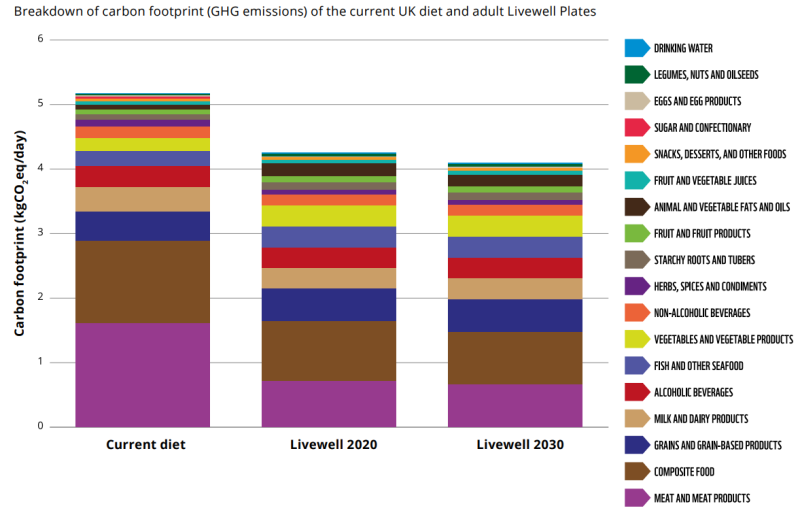8.1.2
Diets
What food is consumed, where it comes from, how it is produced and transported, how it is prepared, and how unwanted food is disposed of all influence the footprint of the UK population’s diet. The UK’s food system represents approximately 19% of the country’s total emissions.[130] Reducing food-related greenhouse gas emissions is a key action area for the retail industry to hit its net zero targets.
Emissions profile
WWF estimates that the current diet of UK adults has a carbon footprint of 5.2kg CO2e/day per individual,[131] with food accounting for 25% of the annual footprint of the average UK resident.[132] The graph below demonstrates how the breakdown of the ‘current diet’ translates to carbon footprint. ‘Meat and meat products’ account for the largest single contribution to diet-related greenhouse emissions, and the ‘composite foods’ category, which includes meat protein products, also contributes significantly to the overall footprint.[133] Also presented on the graph are WWF’s proposed Livewell 2020 and 2030 diets that illustrate the dietary changes by 2020 and 2030 that could keep the average global temperature rise well below 2°C.

Figure 8.1f: Livewell Plates diet emissions breakdown, from WWF
Routes to decarbonising diets
Helping customers shift to more sustainable diets, with more plant-based proteins and foods, can deliver significant carbon savings. Animal proteins are the most significant source of dietary carbon emissions. Average UK protein consumption is already significantly above the dietary reference values, and there are significant opportunities for shifts towards plant-based proteins – for example meat replacement products, non-dairy milks and cheeses, and blended meat and plant protein products. There are also opportunities to help producers reduce the carbon intensity of meat that is consumed.
There are huge variations in carbon emissions between different producers of the same type of food. By helping customers shift their purchases to lower impact suppliers further significant emissions savings are possible.[134]
Approximately 14% of all food purchased in the UK is thrown away. Not only are there significant greenhouse gas emissions associated with the production and preparation of this food, but waste food releases methane (an important greenhouse gas) as it decomposes in landfill. Half of households in England do not have access to collection of separate food waste.
[130] Food systems and greenhouse gas emissions (2015). Food Climate Research Network.
[131] Eating for 2 Degrees: New and updated livewell plates (2017) - WWF
[132] What we buy, and land use, food and farming (2020). Climate Assembly UK.
[133] Meat food supply quantity (kg/capita/year) – UN Food and Agriculture Organisation (FAO)
[134] Behaviour change, public engagement and Net Zero (2019). The Committee on Climate Change